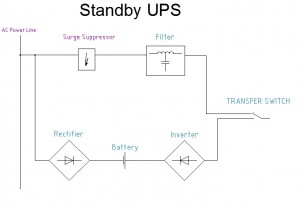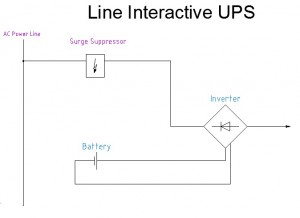UPS “Uninterruptible Power Supply”, which is an electrical system designed to monitor and, if necessary, regulate the main (grid) power source of a load and provide emergency power to the load whenever the main power source fails, without any interruption to the load’s power feed and/or effect on the load’s operation and/or performance.
Standby UPS is the most common and economical type of battery powered UPS system available. With this type of UPS the powered equipment is connected directly to the utility power line without any form of voltage regulation. At the same time the UPS is charging / maintaining its batteries via an rectifier (AC to DC converter). When the utility power fails, the inverter (DC to AC converter) of the UPS will turn on and supply the load with power in a matter of milliseconds.
Most people believe that since the equipment is connected directly to the utility power line it can be easily damaged by a power surge or similar phenomena and the UPS works as nothing more than a short-lived battery so that you can save your files before turning off your computer. That may not be entirely untrue, because a high quality Standby UPS always has a good surge suppression circuit, fuse and also provides more than adequate noise filtration but very low cost / quality products rarely ever feature even the simplest forms of protection. The very high efficiency, simplicity, small size and low cost of the design make it ideal for home and small business users.
Line Interactive UPS is merely an upgrade of the standby UPS and it is an offline type of system.
By adding a voltage autotransformer which can regulate the output voltage, the UPS gains the ability to regulate its output voltage. The inverter of the said UPS system operates at all times, charging the batteries and power the load while the utility power is normal and draws power from the batteries to power the load once the utility power fails.
Because of the autotransformer, the UPS always regulates its output voltage and will not switch to batteries during small undervoltage / overvoltage spikes. This makes it an ideal design for home and small business computers which are powered by an unstable utility power grid. Finally, the presence of the ever-working inverter makes the switching between utility and battery power much smoother, faster and considerably reduced switching transients.
| Used in APC Products | Benefits | Limitations | Findings | |
| Standby UPS | BackUPS | Low Cost, High Efficiency, Compact | Uses battery duringBrownout, impracticalover 2kVA | Best Value forpersonal workstation |
| Line Interactive UPS | SmartUPS, Back-UPS Pro, Matrix | High Reliability, High Efficiency. GoodConditioning | Impractical over 5kVA | Most popular UPStype in existence. Idealfor rack or disctributedServers |

